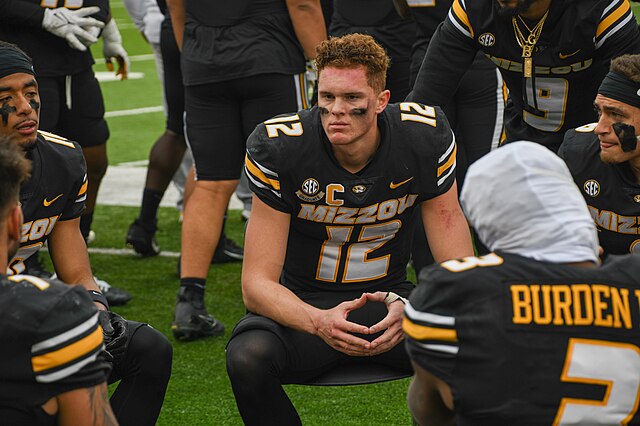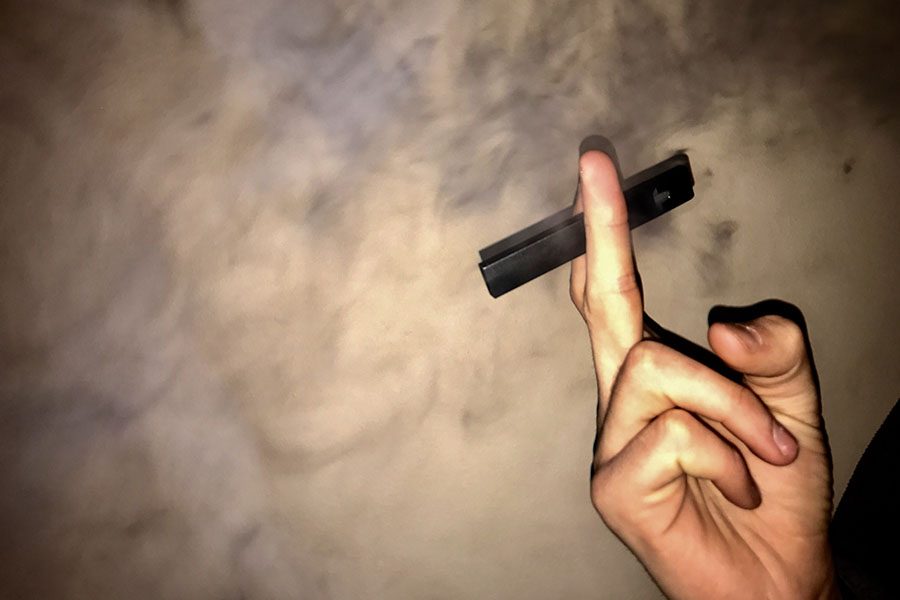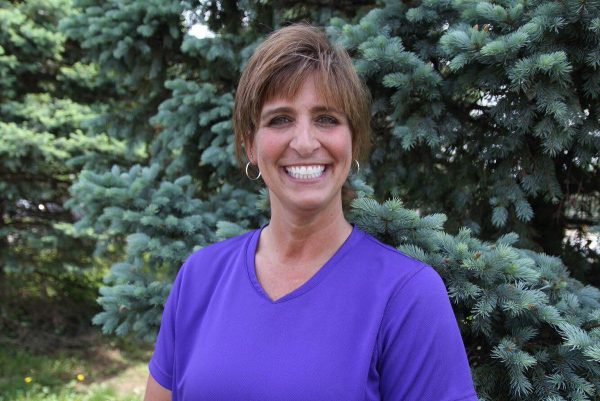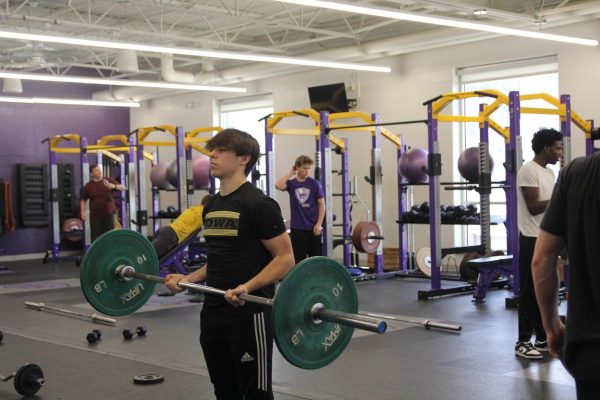Dirty little secret
The thing everyone is doing and no one wants to talk about.
Smoke fills the air after a student inhales from a Juul, Jan. 6.
Today’s high schoolers have grown up with cleaner air than their parents and grandparents because voters decided to ban public smoking in St. Louis County in 2009. The law came into effect in 2011. But students are now experiencing a situation similar to those of their parents who went to school in the 80s when student smoking areas on campus were commonplace.
Whether it’s at sporting events, hanging out with friends, in cars or school bathrooms, teenage vaping has reached an epidemic level.
The number of teenage vapers is rapidly increasing. According to a report from the U.S. General Surgeons Office, e-cigarette use among high school students grew 900 percent between 2011-2015.
E-cigarettes are easily accessible for high school students regardless of the FDA’s recent policy that prohibits minors from purchasing them. The regulation varies in different states and counties between the legal purchasing age of 18 and 21.
For teenage students it is very easy to access these products by asking an older sibling or friend to purchase them. It is even easier for Eureka students who are 18 to drive to Jefferson County and purchase vape products because the legal age for purchasing there is 18.
The information on the health risks of vaping is out there, but it is not talked about enough to help educate users.
“Whenever I’m getting food at Chick-fil-A, going to the gas station or even attending hockey games, I always see someone pulling their vape out,” Elise Moger (10) said. “It even happens in school now, too. I know people are getting fed up with it as much as I am.”
Students have become so dependent on vaping that they can not even last until after school hours to use their devices.
“I don’t believe so many students are vaping. I know so many students are vaping,” Josh Margherita (11) said. “It is an epidemic at EHS, and I do not know how they are going to stop it. Almost everytime I walk into the bathroom someone is going to have a vape in their pocket or be looking over their shoulder just trying to get a quick buzz before class.”
An E-cigarette is a device that heats a liquid containing nicotine and other ingredients into an aerosol for the user to inhale. They are referred to as mods, e-cigs, e-hookahs, tank systems and–the most common–vapes.
They come in various shapes and sizes, some resembling cigarettes, while others resemble flash drives. Teenagers typically use flavored juices in their devices such as menthol, candy, fruit, chocolate and sweets.
The main e-cigarette device that students are bringing to school is the Juul. Juuls are small black and gray devices that look similar to flash drives. The smoke that comes out after they are inhaled is more discrete than of larger tank devices which makes it a lot easier for students to hide the devices in a backpack, pocket or up a sleeve.
The “buzz” from E-cigarette devices is what students are primarily chasing in order to calm their nerves or feel a sense of euphoria for a moment. This high can be achieved from inhaling the vaporized liquid from the cartridges or pods that juice the vape.
Students are typically unaware of what they are actually inhaling into their bodies.
“I know a lot of people are vaping,” Kylie Meyerkord (12) said. “I really do not think any of them know exactly what they are putting into their bodies or the potential health risks that come with vaping.”
The Federal Drug Administration ruled that they will regulate all tobacco products effective since Aug. 8, 2016. However, while e-cigarettes and other vaping products do not contain tobacco most do contain nicotine, so they are not fully FDA approved.
Recently, the FDA has been trying to impose regulations on e-cigarette products like asking manufacturers and sellers to include a warning label, ingredients list and the amount of nicotine in each product.
Not all E-cigarette companies follow these suggested regulations on their products, so people can still be blindsided by what is truly in their devices.
Those who purchase these products may believe that their E-cigarettes are purely water vapor when in reality they contain a list of harmful ingredients.
“Nicotine is highly addictive, but is not the only chemical that you have to be concerned about when your breathing in an e-cigarette,” Alison Stambaugh, NCADA prevention specialist, said. “Other chemicals include propylene glycol, tin, copper, nickel, formaldehyde, acetic acid and acetone. There is also a chemical called diacetyl in some e-cigarette products that can cause popcorn lung.”
Popcorn lung is the scarring of the tiny air sacs in the lungs that causes the airways to narrow and thicken. It is a serious lung disease with effects similar to those of chronic obstructive pulmonary disease. Those affected may experience coughing, wheezing and shortness of breath.
Popcorn lung is just one of the many health risks that come with vaping.
In a study conducted by Irfan Rahman, a toxicologist at the University of Rochester in New York and his team, they discovered that vaping promotes gum disease, delays repair of cells in the lungs, causes bloody mouth sores and can lead to Smoker’s cough.
While these long-term effects take time to manifest, access to devices is often a matter of moments.
Easier access has allowed for more students to get a hold of the devices…and bring them to school. The inability to refrain from vaping for the duration of the school day is a sign of addiction and should be a cause of concern.
“I’d say the number of students I see in my office for vaping is sporadic,” George Calhoun, 9th grade principal, said. “In classrooms I have not personally caught kids, but I have had teachers catch them and then send them to my office. I have previously caught kids in the restrooms. Typically it could be multiple students at a time or it could just be just one student who decided to vape really quickly in the restroom, and then you catch them..”
Faculty are adjusting to address the issue.
“Some students are carrying around Juuls and are asking teachers if they can plug them into outlets in the room to charge them,” AnnMarie Gilman, 10th Grade principal, said. “These devices have gotten smaller and smaller and actually do look like flash drives, so it is hard for teachers. Their focus is to help kids learn, focus in a content area and take care of that room. We really don’t expect teachers to be on the frontline of knowing what it is, but yet we’re doing our best as an administrative team to to educate our teachers on vaping.”
Administrators have asked teachers to watch over specific bathrooms and keep their eyes open during class.
“I have never had a student vape in my class, but we know that students vape in the bathroom up here in the math hallway,” Michael Hanna, Math, said. “That’s what we are suppose to watch out for.”
The district’s vaping policy states, “If students are caught with anything that can be used to smoke or vape they will immediately be referred to the office and their possessions–including their cars–may be subject to search, which will result in in-school suspension or out-of-school suspension. Students are not allowed to be in possession of lighters or anything that can be used to smoke. Smoke or vapor coming out of students’ mouths is an offense.”
If a student is caught vaping or in possession with a vape, discipline will proceed.
- First Offense: minimum three days of I.S.S.
- Second Offense: minimum three days of O.S.S.
- Third Offense: minimum five days of O.S.S.
Students are allowed to be searched as a result of the 1985 Supreme Court decision: New Jersey v. T.L.O. In a New Jersey high school, a teacher found two girls smoking in a bathroom and took them both to the principal’s office.
One of the girls, known as T.L.O., denied that she was smoking. The principal searched her purse and found evidence of marijuana. In a juvenile court, T.L.O argued that the principal violated her Fourth Amendment rights of unreasonable search and seizure.
The United States Supreme Court heard the case and sided with the school stating that the school had met a reasonable standard for conducting the search at school.
The court also ruled that school administrators do not need a search warrant or a probable cause to search a student because students have a limited expectation of privacy at school.
“It is not what you will look back on in 10 to 15 years and think, ‘Wow! I was cool for vaping in high school,” Hanna said. “Especially vaping at high school seems like a dumb idea. It seems like not as many kids are smoking cigarettes as it was when I was a kid, but it seems like vapes are taking their place.”
Students ultimately have the voice and power to end this epidemic.
“I would like to see some of our prominent students take a stand against vaping,” Gilman said. “Walking into the bathroom when you know it’s happening and stopping it. I think in spite of all the rules, policies and regulations, the people who truly have the powerful voice in this building are the students. I think that if students took a stand against it, it would really matter.”
However, student don’t want to even talk about vaping. A dozen people declined to be interviewed for the story.
“I would like to tell students who vape at school to stop,” Graham Hastings (12) said. “It’s a distraction to not only teachers but to other students as well. If you vape, just do it on your own time. No one needs to bring it into school.”
Your donation will support the student journalists of Eureka High School - MO. Your contribution will allow us to purchase equipment and cover our annual website hosting costs.

Glascock is a news reporter for the EHS-hub. This is her second semester on staff. Her hobbies include travelling, writing, hanging out with friends, going...



















Taylor Werges • Jan 11, 2018 at 10:12 AM
Such a great story Lauren! Well said. Hopefully this sheds a bigger light on this issue.